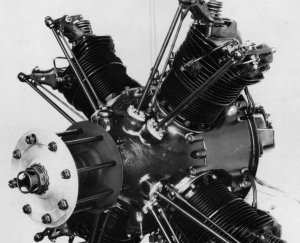
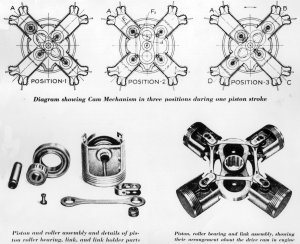

Fairchild (Ranger)
The Fairchild Aerial Camera Corporation of Farmingdale, Long Island, New York, entered the aircraft engine business in 1925 by forming the Fairchild-Caminez Engine Corporation to develop and produce a novel air-cooled, 4-cylinder, 4-stroke radial that Harold Caminez had prototyped for the US Army Air Corps.
The Fairchild-Caminez Model 447 converted reciprocating motion of the pistons into rotary motion by means of rollers on the pistons that followed a double-lobed cam on the output shaft. The piston rollers were kept in contact with the cam by link rods that formed a parallelogram. This scheme doubled the number of power strokes per revolution of the output shaft. With a bore of 5.625", a stroke of 4.500", and a compression ratio of 5.2:1, the Model 447-C displaced 447.3 in³, produced 120 hp at 960 rpm, and weighed 340 lb. Although the Model 447-C had the distinction of receiving Department of Commerce Approved Type Certificate No. 1, it suffered from torque roughness and high piston side loads. An 8-cylinder 2-row version was built and tested, but all cam engine development was ultimately abandoned.
 |
 |
 |
| Fairchild-Caminez Model 447-C | Model 447 Mechanism | Model 447-C Installation Drawing |
The Fairchild 6-370A began development in May, 1929, and was the first project of a new company, the Fairchild Engine Corporation, which eventually became part of the Aviation Corporation. This air-cooled inverted 6-cylinder in-line had a bore of 3.938", a stroke of 5.125", a displacement of 374.4 in³, produced 120 hp at 2,000 rpm, and weighed 325 lb. Separate steel cylinder barrels with integral machined cooling fins were screwed and shrunk into cast aluminum alloy cylinder heads. Each cylinder assembly was held to the crankcase by eight studs. A casting bolted to all six cylinder heads housed the camshaft and rocker arms, and a cam housing cover served as an oil sump. The roller rocker arms ran against a single overhead camshaft and actuated valves separated by an angle of 60°. The crankcase was split through the crankshaft main bearing centerline, and provided seven main bearings saddles. This construction was to be a hallmark of all future Fairchild engines.
The Fairchild 6-390 was similar to the 6-370, but had a 4.000" bore and a displacement of 386.4 in³. Producing 120 hp at 2,150 rpm, the 6-390 weighed 345 lb. It received Approved Type Certificate No. 57 on 14 Jul 1930.
The Fairchild V-770 shared many features and parts with the 6-390. This inverted V-12, with a 4.000" bore and 5.125" stroke, displaced 772.8 in³, and produced 250 hp at 2,150 rpm from 548 lb.
In early 1931, the American Airplane and Engine Corporation, a manufacturing division of the Aviation Corporation, was formed to take over Fairchild aircraft engine manufacturing activities. The Fairchild 6-390 became the Ranger 6-390 and the Fairchild V-770 became the Ranger V-770. Eventually, Ranger Engineering, a division of the Fairchild Engine & Airplane Corporation, took over manufacture of Ranger engines.
The Ranger 6-390 was refined through the B, C and D models. The 6-390-D4, which received Approved Type Certificate No. 188 on 30 Oct 1937, produced 150 hp at 2,350 rpm, and weighed 350 lb.
The Ranger 6-410 was introduced in Dec 1937. With a bore increase to 4.125", it displaced 410.9 in³, produced 165 hp at 2,450 rpm, and still weighed 350 lb.
The Ranger 6-440 kept the same bore of the 6-410, but increased the stroke to 5.500", for a displacement of 441.0 in³. The 6-440C-2 model, initially certified on 65 octane fuel, produced 175 hp at 2,450 rpm and weighed 355 lb. Developed for US Army Air Corps primary training, it was eligible for all primary trainer competitions. It also received Approved Type Certificate No. 216 on 20 Jul 1939. The 6-440 series was continually refined to take advantage of better fuels, and the 6-440C-5 ultimately produced 220 hp at 2,450 rpm. It was built in profusion for the Army Air Corps and powered the Douglas O-14, Fairchild PT-19, T-19, PT-26, UC-61 and UC-86, and the Northwestern-Waco PG-2.
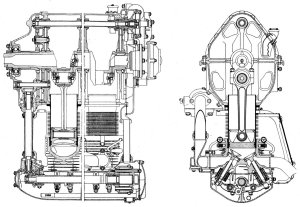 |
 |
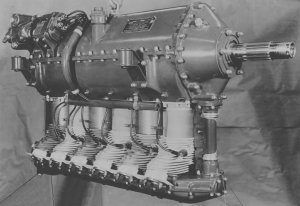 |
| Fairchild 6-Cylinder Sections | Fairchild 6-390-B | Ranger L-440-3 |
- L-440 Details in the Members’ Section -
Ranger Engineering continued to improve the V-770 engine series, adding propeller reduction gearing, supercharging, and other refinements. This process finally led to a takeoff power of 575 takeoff hp at 3,400 rpm in the SGV-770-D4. V-770s were used in US Army Air Forces aircraft, including North American T-6E, Bell XP-77, Bellanca YO-50, and Fairchild AT-14A and AT-21. It was tested in a couple of Navy aircraft, and saw service in the Curtiss SO3C Seamew, an aircraft whose combination of aerodynamic and engine cooling issues made it decidely unsuccessful.
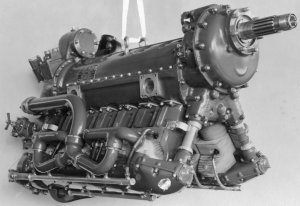 |
 |
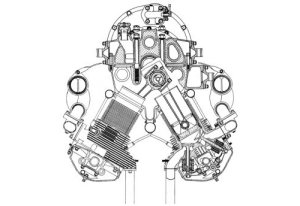 |
| Ranger V-770 | Ranger SGV-770B-6 Longitudinal Section | Ranger SGV-770B-6 Transverse Section |
On 20 Feb 1943, Ranger Chief Engineer EM Lester and Ranger representative GI Carlson met with the Chief of Materiel Command's Experimental Engineering Division to present characteristics of proposed XV-920 and XH-1850 engines. Ranger was directed to deliver specifications and drawings to Materiel Command to by 15 Mar 1943. Ranger's Lester and Carlson again met with Materiel Command's EP Kiefer and Lt DM Thompson on 14 May 1943. Most of the discussion involved XH-1850 installation aspects in a single-engine, single-place pursuit aircraft. Ranger agreed to submit cooling air requirements, investigate approaches to making the engine more compact, and investigate whether a V-12 with similar displacement was feasible. Penciled into the margin of the inter-office memo documenting the meeting is a note from Kiefer, "First, they had better make the most of the V-770 engine."
The XV-920 was to have the same 5.125" stroke and construction similar to the V-770, but the bore was to be enlarged to 4.375", producing a displacement of 924.5 in³. It is not known whether any XV-920s were built.
The XH-1850 used the same cylinders, bore, and stroke as the XV-920 for a displacement of 1849.1 in³. Output of the supercharged XH-1850 was projected to be 1,200 hp. Ranger engineers spaced adjacent cylinder banks at a 30° included angle, producing a flat-X configuration. Eight XH-1850 engines were built, and at least one, an XH-1850-2, survives in the collection of the National Air and Space Museum. The XH-1850-2 produced 1,500 hp at 3,500 rpm, and weighed 1,735 lb. It featured a hollow propeller shaft through which a cannon could be fired.
 |
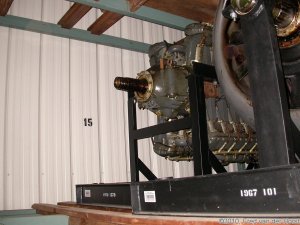 |
| Ranger XH-1850 | Ranger XH-1850 |